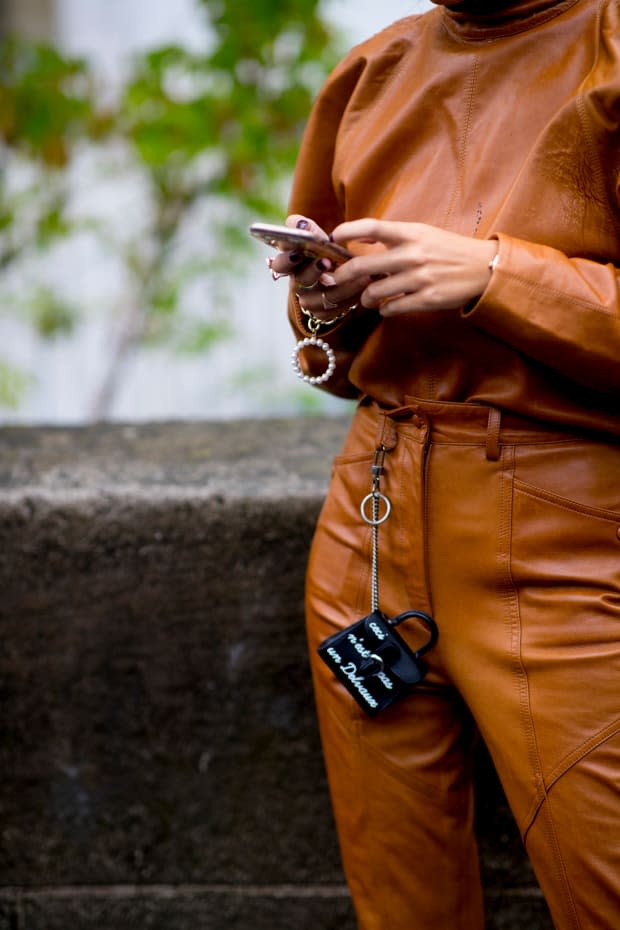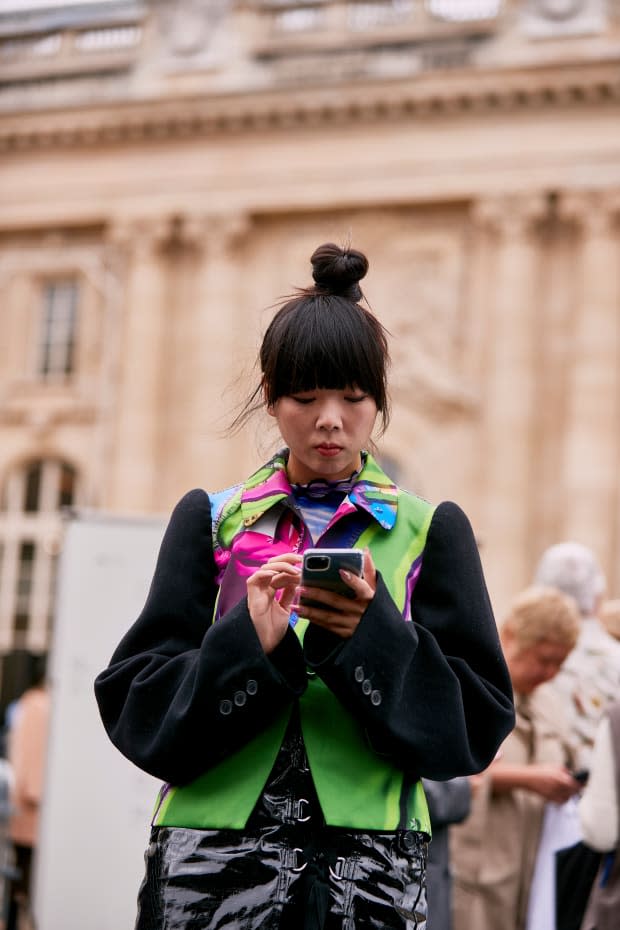Why Are All the Brands Texting Me? An Investigation
As it turns out, many brands are finding success with this strategy.

It began inconspicuously enough. Twenty-three days before Christmas, I received a text message from someone that my smartphone detected as "Lucy." The last Lucy I knew and interacted with in real life was a woman I met while interviewing for a job more than five years ago. I was pretty sure it wasn’t her.
When I opened the text, I saw a gif of two rotating images. It was a blonde model with dewy skin and those effortless beachy waves I can never do on my own hair. "24 hours only. 50% off sitewide," the copy over it read. A special promo code was also included.
"Lucy," apparently, worked at a beauty brand I've regularly shopped at for years. "Hey there!" she wrote casually, as if a long-lost friend attempting to reconnect. She told me that "better brows [were] this way," and provided a direct link to the brand's big online sale. I didn't think much of it. I wasn't in the market for anything at that moment, so I shrugged off the text as a one-time thing.
But then, the next day, Lucy reached out again, wanting to let me know that it was the "last call" to buy one of the brand's full-size eyeshadow palettes and receive a travel size version for free. Another special promo code was included. The next, next day, she reached out yet again. In total, I received 14 texts from the brand over a three-week period in December. By that point, I was feeling a bit, well, hounded.
"Have you been getting texts from...brands?" I asked a friend one day. "Yes," she responded, letting out a sigh of exasperation before adding, "It's kind of a lot."
It is a lot. And I was just getting texts from that one. My friend — who, somewhat ironically, works as a brand manager — told me she was getting inundated with texts from brands of all sizes, from digitally native startups to multimillion-dollar corporations.
I had no idea the strategy was so widespread.

"Consumers are increasingly desiring personalization in their shopping experiences," Joy Lu, assistant professor of marketing at Carnegie Mellon University's Tepper School of Business, tells Fashionista. "[This] can be achieved through machine learning and artificial intelligence algorithms, but also through a human touch, which can be facilitated via text messaging, which feels more like an instant interactive conversation."
What's more, Lu explains, brands are also vying for consumer attention in an increasingly saturated and distraction-filled market. Sending texts can cut through the noise and give brands a much-needed advantage over traditional email marketing, which tends to crowd inboxes more than anything else.
But are texts really that much different from emails, especially if you're receiving an onslaught of them over a relatively short period of time?
Related Stories:
The Hot Trend in Luxury Retail? Not Selling Anything
The Line Between Social Media and E-Commerce Is Beginning to Disappear
Can Mass Influencer Marketing Backfire for Brands?
"It's important to understand that text messaging might not be appropriate for all brands, and might not necessarily be preferred by all consumers," Lu says. "There needs to be a clear benefit to the consumer, match the brand's overall image, and consumers need to be able to opt out if they want to."
Of the 14 texts I received from that beauty brand, only one gave me the clear option of opting out. (It was text message number nine.) Indeed, the fact that this option wasn't explicitly spelled out from the very beginning frustrated me more than the texts themselves. I was also a bit turned off by the texts' overall sales-y approach. Even though I had given the brand my phone number when I ordered from them, the whole thing just felt somewhat invasive. Perhaps if I'd initiated the interaction, I would've felt differently.
As it turns out, many brands are finding success with the texting strategy. I received a tip from a woman who raved about a recent customer service experience with Mejuri — the Toronto-based direct-to-consumer brand known for its delicate, classic jewelry — all of which took place via text message. I reached out to the company to learn more.
"Text messaging allows our customers to have a direct dialogue with our Customer Happiness Team and receive a response back within minutes," says Mary Anne Savoie, director of customer experience at Mejuri.
The whole process is pretty simple: People text the brand with issues or concerns, directly interacting with a Mejuri representative who can help them solve their problem. "Not only does this method of communication enable faster and more convenient decision making, but it maintains a strong, genuine relationship with our customer," Savoie explains. "Our customers appreciate not only the quick response, but that their feedback is taken seriously — it often informs future product launches and allows us to iterate efficiently."
Mejuri also uses text messages to send restock updates, but customers must opt in to receive those communications. Savoie says texting has been "extremely successful" for the brand, underscoring one critical point: "We never initiate a conversation first, which allows us to ensure that the relationship is at the customer’s convenience."
And that, right there, is the key difference. I'd be perfectly fine with a brand texting me if it was in response to, say, a question I had with an order. Or to let me know the item I've had on my wishlist has been restocked in my size. Anything beyond that feels excessive — and the brands I spoke to are acutely aware of walking that fine line between being helpful and being overbearing.

"Since you are in this environment that's super private, you need to be much more thoughtful about your communication and cadence," says Felipe Araujo, chief digital officer of the sneaker brand Cariuma. He acknowledges the brand — which launched its texting communications just last September — hasn't figured out that perfect middle ground just yet. But at the very least, it recognizes that middle ground even exists. And that's essential if brands want to be successful using this strategy in the long term.
"This is a very new channel for us and for most brands, and how deep our users are letting us into their lives is a privilege we wouldn't want to take advantage of," Araujo says. "It has created a method for us to be part of a channel that’s normally reserved for friends and family. To welcome us there, we feel it means that they are super engaged and they want to have a deeper, more meaningful relationship."
For Cariuma, that mindfulness is paying off: According to the brand, its open rate of texts is almost 100% in comparison to "strong email campaigns" that are somewhere in the 20-30% range. "We have seen click through rates at three to four times higher than average email campaigns, and conversion rates two times higher than email," Araujo shares. "Overall we've been really happy with the results of our program so far."
Jenni Kayne, a California-based lifestyle brand with fans like Gwyneth Paltrow, Jessica Alba, and Kristen Bell, has experienced similar success with its texting strategy, which the brand launched last summer.
"Since launching in June of last year, our text program has contributed to 8% of total revenue, with a strong conversion rate," says Samantha Moore, director of marketing and partnerships at Jenni Kayne. "Much like all of us, our customers are busy and on the go — and always have their phones with them. Texting gives us the opportunity to reach our audience both swiftly and in an incredibly seamless fashion. It's also a much more personal form of communication."
Through texts, Moore says, the brand can take on a more casual, friend-like tone and engage with its audience "in a way that feels human."
Since customers — millennials and Gen Z-ers in particular — are increasingly craving more authenticity from the brands they shop from and interact with, it makes sense that companies are wanting to meet them in one of the most intimate spaces possible. But entering that space requires an incredible amount of self-awareness on the part of the brand, regardless of its end goals as a business.
"No matter how useful the channel proves to be, we're always cognizant of the frequency," Moore says. "It's a tool you have to be careful with."
Want more Fashionista? Sign up for our daily newsletter and get us directly in your inbox.
